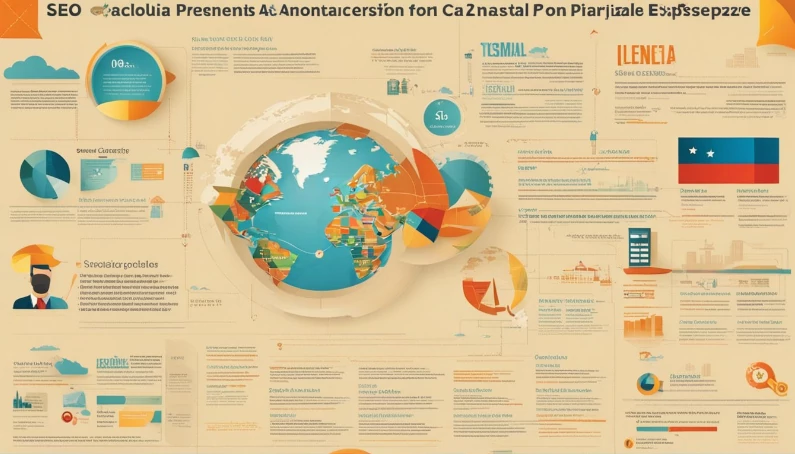International SEO is one of the activities of our international SEO agency. It is essential for companies and e-commerce that want a solid online presence globally and reach different markets.
Many sites, including Italian ones, try to project themselves into the world by providing a multilingual site. The mistake is that they often stop at this.
On this page we will see which factors as an SEO expert I consider important for good international SEO.
What is international seo?
International SEO is an SEO strategy aimed at improving the visibility of a website in different countries, regions or specific languages.
With this practice we focus on adapting the website and content to meet the needs of an international audience. The goal is to rank on globally relevant search engine results pages (SERPs).
The reference search engine for international SEO is Google, which dominates over 90% of global Internet search traffic.
Focusing on improvements in this search engine is a smart move.
Why is international SEO important?
If you want to expand your product or service offering in foreign markets, implementing a solid international SEO strategy becomes essential for several reasons.
Here are the reasons why you may need a comprehensive international SEO strategy:
Customization for specific markets: personalize content according to the particular needs of various markets and satisfy a diverse audience while avoiding unsatisfactory user experiences.
Increased visibility in search: a good international SEO positioning strategy increases the visibility of your site in search engine results in target regions. This increases site visibility abroad and improving conversion rates.
Engage multilingual users: optimizing your site for multiple languages welcomes users who don’t speak your language. Your potential customer base becomes larger, improving user experience and increasing your brand’s reputation.
Consistent brand presence: a global SEO approach allows you to maintain a consistent brand presence across all regions.
Identify growth opportunities: as your strategy develops, gain valuable insights into the pain points and opportunities within each new market. This will allow you to optimize your SEO tactics.
Main components of international SEO
The factors of foreign SEO vary from normal national SEO
Below we see the main components of international SEO, deferring the other related components to an in-person meeting:
- to technical SEO,
- to international seo keyword research,
- to the backlink strategy
- and adaptation to local search engines.

Schedule a free consultation now!
URL structure
An important aspect of international SEO for web agency is optimizing your website’s URL structure.
Using top-level domains with country codes (ccTLDs) or language tags can help indicate the target country or language. This allows Google to identify the correct language version for different users.
In essence, the URL structure helps tell search engines the target language or region of each page on your website.
A well-defined URL structure helps avoid content duplication issues. It also helps improve relevance in search results specific to each language or region.
The choice of URL structure depends on your needs, the complexity of the site and the resources available.
It is important to maintain consistency in structure and ensure that pages are clearly identified by language or region.
Additionally, correctly implementing hreflang tags is essential for telling search engines how different versions of your website correlate.
Below, are the main options for URL structure in international SEO:
Country code top-level domains (ccTLDs)
Examples : www.example.co.uk (for the UK), www.example.de (for the German version).
Advantages : This is the clearest and most geographically specific option, favorable for geotargeting.
Disadvantages : Requires purchasing a separate domain for each language or region: more costs and more complex management.
Subdomains
Examples : us.example.com (for the US version), de.example.com (for the German version).
Advantages : You keep the main domain and create subdomains for each market.
Disadvantages : It may be less clear than ccTLDs, but it still offers a good indication for search engines.
Subfolders
Example : www.example.com/fr/ (for the French version), www.example.com/de/ (for the German version).
Advantages : Very common and less expensive option than ccTLDs, as it uses the same main domain.
Disadvantages : Option that may be less clear to search engines than ccTLDs, but still effective.
Parameters in the URL
Example : www.example.com?lang=fr (French site), www.example.com?lang=de (German site).
Advantages : Flexible option, but not the most recommended for international SEO.
Disadvantages : URLs are complex and less clear to search engines and can create content duplication problems if not managed correctly.
Subdomains with language prefix
Example : fr.example.com (for the French version), de.example.com (for the German version).
Advantages : This option combines the use of subdomains with a language prefix to indicate the target language or region.
Disadvantages : URL lengths may increase, but it’s still a solid choice.
Content optimization in international SEO
Optimizing existing content or creating new content in international SEO requires a strategic and detailed approach.
We understand the needs and preferences of your local audience and tailor your content accordingly. This way, we can improve your visibility in search results and offer a quality experience to international users.
We use keyword research tools to locate popular search terms in your target language. This way we can create relevant content that meets the search intent of your international audience.
Here are some guidelines for optimizing content in international SEO:
Accurate and natural translation
We ensure that content translations are accurate and natural. We avoid literal translations that might sound unnatural or confusing to native readers.
We consider the use of native translators or professionals experienced in translating texts into the target language.
In addition to the website content, we carefully translate metadata and documents into the target languages, taking into account cultural and regional differences. A useful tool for this task is the document translator offered by Canva. Thanks to this tool we can obtain faithful translations with respect to the contents of Docs and PDFs from which to study the content in the native language.
Localized keywords
We search for specific keywords for each target language or region. This will help us understand how local users search online.
We use these localized keywords in image titles, descriptions, main content, and ALT attributes.
Localized meta tags
We optimize meta tags, such as the page title (meta title) and description (meta description), for each language or region. These items appear in search results and influence click-through rates.
We use keywords relevant to the target language or region in the meta tags.
Localized content
We tailor content to reflect the culture, habits and preferences of your local users. This includes using local examples, cultural references and content that resonates with your target audience.
We provide information relevant to the local market, such as reviews, physical addresses, local phone numbers and opening hours.
Hreflang tag
This helps search engines understand which version of your content to show users based on their language and geographic preferences. This helps search engines understand which version of your content to show users based on their language and geographic preferences.
Original content
We avoid duplicate content between different language or regional versions of your website. We keep the content original and distinct for each page.
Content duplication can be bad for SEO.
Language labels in sitemaps
We make sure your sitemap includes information about the language or region of each page. This can help search engines index your international site correctly.
Clear URL structure
We use a clear and consistent URL structure that clearly indicates the target language or region. For example, consider using subdomains, subfolders, or country code top-level domains to differentiate versions of your site.
Relevant internal links
We create internal links between different language or regional versions of your pages when it makes sense. This can help keep users on your site and improve user experience.
Performance monitoring
We use web analytics tools to monitor the performance of different language or regional versions of your site. This will allow us to make changes and optimizations based on data and user behavior.

International keyword research?
Here are the key steps to conducting effective keyword research in international contexts:
We understand your target markets: before starting any keyword research, we need to have a clear understanding of the countries or regions where we want to optimize your website. We identify priority markets based on your business objectives.
We know the languages: If you are targeting an international audience, we need to know the languages spoken in your target markets. This will help us identify the correct keywords in each language.
We use keyword research tools: We leverage keyword research tools, such as Google Keyword Planner, SEMrush, Ahrefs or others, to find relevant keyword suggestions for each country or language. We can set the language and geolocation to obtain specific data for each market.
Let’s explore cultural differences: cultural nuances can influence how people search for information online. We study cultural preferences and trends in your target markets and reflect this knowledge in your keyword research.
We adapt your keywords: we don’t simply translate the keywords from English or another main language. Each market may have unique research needs. We make sure to adapt keywords based on linguistic and cultural nuances.
We evaluate the competition: we analyze the competition for keywords in your target markets. Let’s find out who the main competitors are and how they rank for relevant keywords.
We look for long-tail keywords: long-tail keywords are longer, more specific phrases that your potential users might search for. They are often less competitive and can generate highly targeted traffic.
We check search volume: We check the monthly search volume for each keyword in each language or country. It is important to select keywords that have significant search volume to justify your optimization efforts.
We examine search trends: we examine search trends over time to understand whether a keyword is growing or declining. This helps us keep your international SEO strategies up to date.
Let’s create a content plan: we use the identified keywords to develop an international content plan. We make sure the content is relevant and high quality in each language or region.
We monitor and adapt: after we optimize your website with new international keywords, we constantly monitor performance and make adjustments based on the results. Search trends can change over time, so we keep up to date.

FAQs
What is International SEO? International SEO is the optimization of a website to improve its ranking in the search engines of different countries.
Why is international SEO important? It is important for companies that want to expand their presence beyond national borders and reach a global audience.
What are the benefits of multilingual SEO? Increase the relevance and accessibility of content for users who speak different languages, improving user experience and local search engine rankings.
How to choose keywords for international SEO? It is important to conduct market research to identify keywords with a high search volume in your target language.
What are the main challenges of international SEO? Challenges include managing linguistic and cultural differences, as well as optimizing for local search engines.
What tools can help with international SEO? Tools like Google Keyword Planner, Ahrefs, and SEMrush can be useful for keyword research and market analysis.
How to adapt content for international SEO? In addition to translation, content must be culturally relevant and adapted to the preferences of local audiences.
What role do local search engines play in international SEO? Optimizing for local search engines like Baidu in China or Yandex in Russia can significantly improve your rankings in their respective markets.
What are the benefits of working with an international SEO agency? An experienced agency can offer specialized skills, advanced resources and in-depth knowledge of the dynamics of global SEO.
How to monitor and adapt an international SEO strategy? It is essential to constantly monitor site performance and adapt strategies in response to changes in the market and search engine algorithms.

